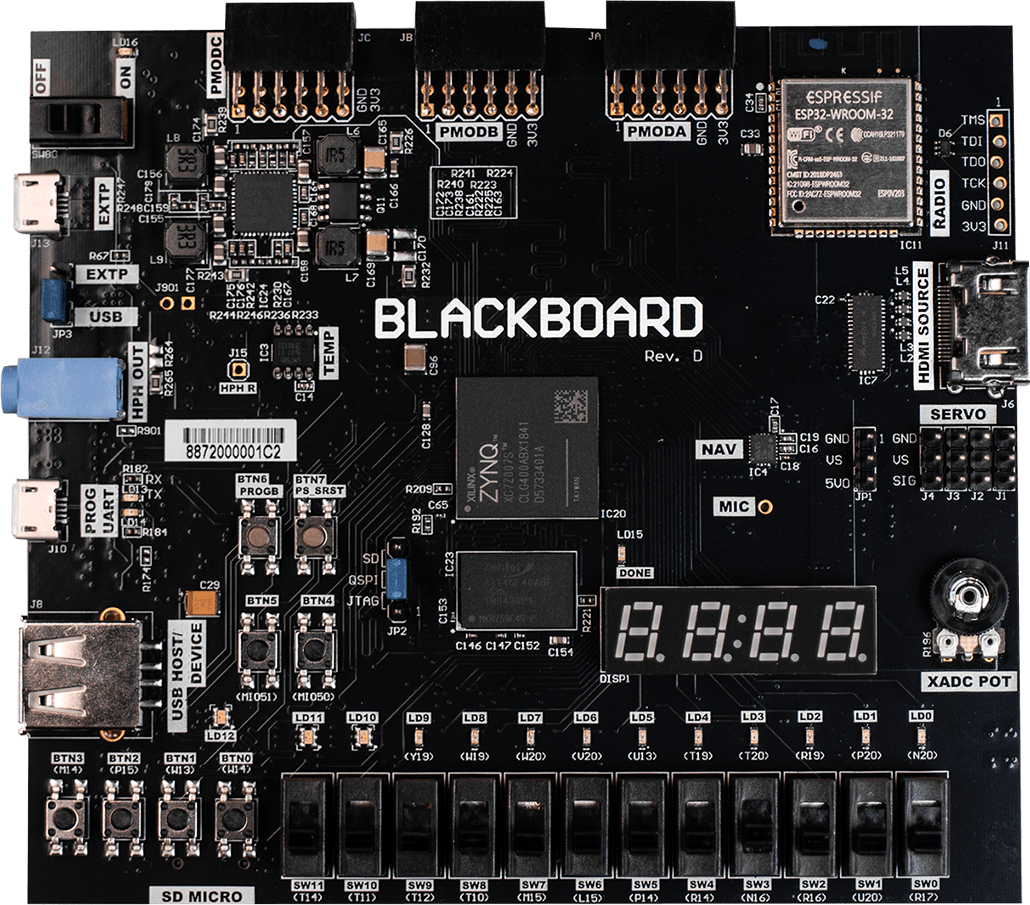Blackboard
The Blackboard is an ARM and FPGA development board designed specifically for electrical and computer engineering education. Based on the ZYNQ device from Xilinx, the Blackboard offers an FPGA for digital logic applications and an ARM Cortex-A9 for microprocessor applications. A single USB cable provides power and a programming port, and a large set of peripherals allows any number of hardware and software designs to be implemented without the need for any other components.
When used in a digital logic class, the FPGA can be used by itself without any involvement or interference from the ARM processor. On-board devices and ports like pushbuttons, slide switches, LEDs, 7-segment displays, HDMI/VGA, audio in/out, and UART/COM are all connected directly to the FPGA, allowing the Blackboard to be used as an advanced stand-alone FPGA-based system.
When used in a microprocessor class, the ARM processor can be used by itself, and the FPGA can be completely ignored. On-board sensors, including an accelerometer, gyroscope, magnetic compass, and thermometer, and ports like WIFI, Bluetooth and USB OTG are connected to the ARM using standard serial busses, allowing the Blackboard to be used as an advanced ARM development platform. And further, a standard configuration makes all FPGA-connected I/O devices available to the ARM through well-documented register-based interfaces.
When used in a digital systems class, the FPGA and ARM can be used in conjunction to implement systems that include both custom hardware and software. Custom Verilog or VHDL designs can be easily added into the ARM system, and custom Assembly or C code can be written to interact with them. This powerful feature allows students to create unique and high-performance and digital systems, and to explore tradeoffs between hardware and software-centric designs.
- Xilinx XC7007S ZYNQ (ARM Cortex-A9 processor and Artix FPGA)
- 512MB of fast DDR3 memory
- USB OTG host port
- USB port for power, programming, and COM port
- On-board WIFI and Bluetooth (ESP-32 radio module)
- 16 MB QSPI ROM
- SD Card slot
- Microphone (MEMs PDM)
- Audio out (PWM)
- HDMI Source port up to 1080p
- Accelerometer (SPI)
- Gyroscope (SPI)
- Magnetic Compass (SPI)
- Temperature Sensor (I2C)
- On board ADC with thumbwheel potentiometer
- Four servo connectors (conventional or continuous rotation)
- 12 slide switches, 6 pushbuttons
- 4-digit seven-segment display, 10 discrete LEDs, 2 RGB LEDs
- 3 Pmod connectors
-
Getting Started
An overview of materials, expectations and policies
-
Introduction and Overview
Setting up and Using the Blackboard
-
GPIO
Setup and use of Blackboard's GPIO devices
-
Seven Segment Display
Overview and use of Blackboard's seven-segment display
-
Timer Circuits
ARM's global timer and ZYNQ's triple timer counter module
-
UART Controller
Working with ZYNQ's UARTs
-
SPI Controller
Configuring and using the SPI bus on ZYNQ
-
I2C Controller
Configuring and using the I2C bus on ZYNQ
-
LSM9DS1 Inertial Module
Overview and use of Blackboard's ST LSM9DS1 9-axis inertial module
-
LM75B Temperature Sensor
Overview and use of Blackboard's NXP LM75BDP Temperature Sensor
-
GIC
Setting up and using ARM's Generic Interrupt Controller
-
XADC
Using ZYNQ's Analog to Digital Converter
-
HDMI
Using Real Digital's HDMI IP Core
-
Audio Recorder and Player
Setting up Audio Recorder and player for the Blackboard
